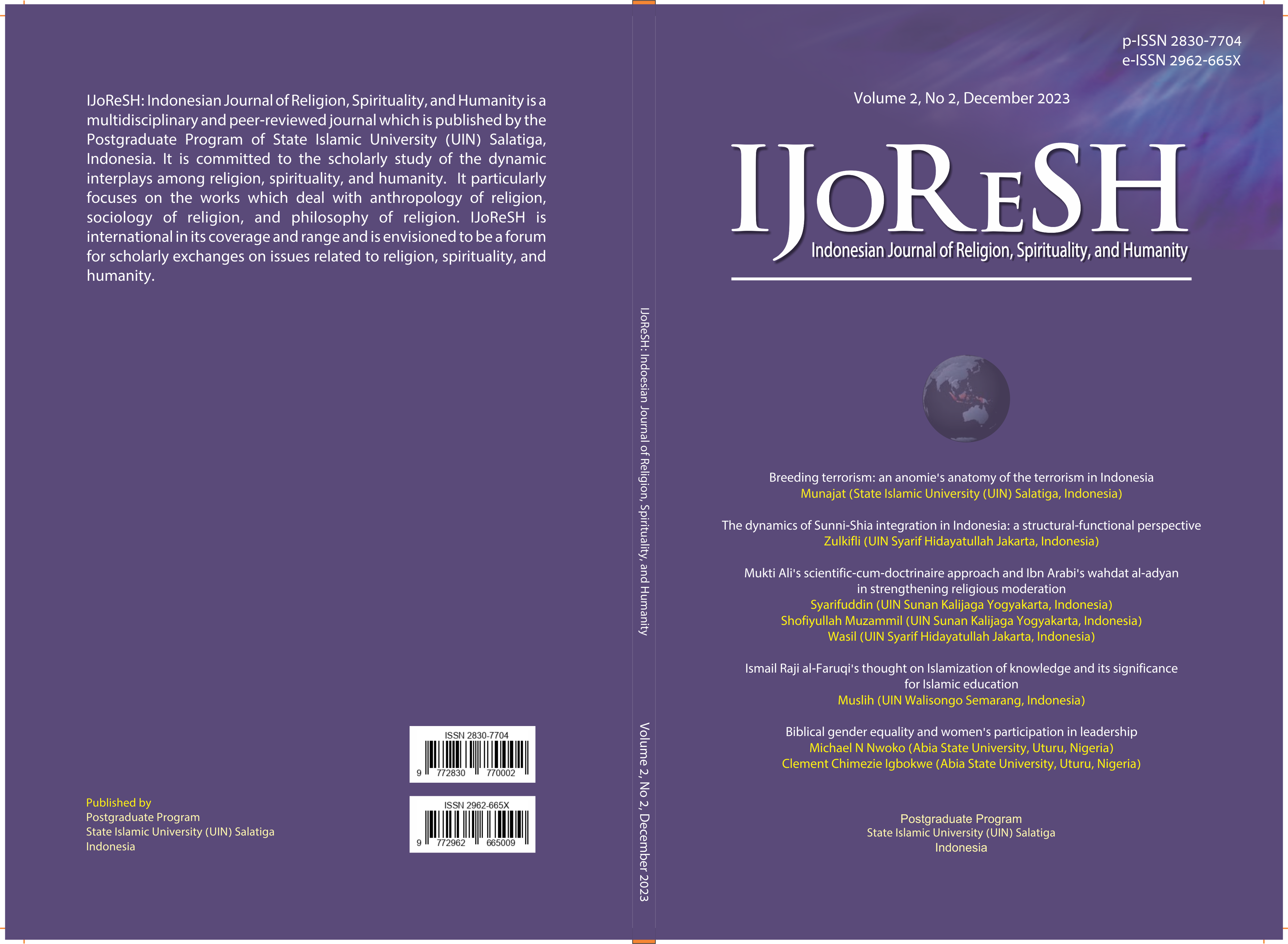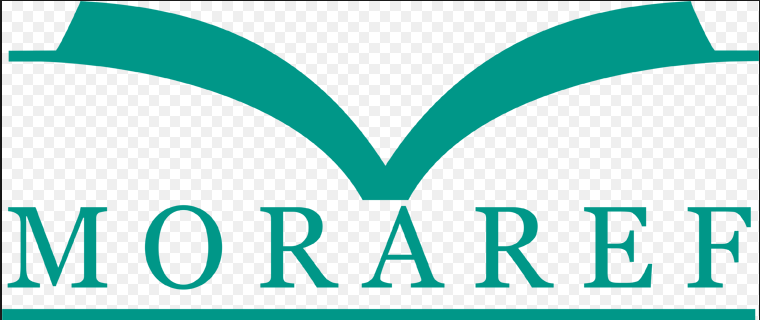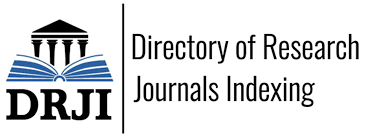The dynamics of religion in public spheres: religious education and religious diversity in Ghana’s public schools
DOI:
https://doi.org/10.18326/ijoresh.v3i2.152-172Keywords:
Public sphere, Religious education, Religious diversity, Religious and moral education, African religionsAbstract
Ghana's religious diversity and the role of religion in public spheres have given rise to unique approaches in Religious and Moral Education (RME) within public schools. This study investigates how RME is taught and the extent to which it addresses religious diversity, drawing on ethnographic data from eight public schools in Accra. Ethnographic methods, including interviews, observations, and focus groups with teachers and students, are employed to understand the challenges and opportunities in teaching religion in a pluralistic context. Findings reveal an imbalance in the representation of various religions, with dominant faiths often overshadowing minority beliefs, particularly Indigenous Religions. Teachers' religious affiliations sometimes influence classroom discourse, leading to an inaccurate portrayal of "religious others" and a simplified understanding of diversity. This research highlights the need for a more inclusive approach in Ghana's RME curriculum to foster equitable, multicultural knowledge among students. This study contributes to discussions on education and religion by advocating curriculum reforms that embrace Ghana's full religious spectrum and encourage critical reflection on diversity in public education settings.
References
Addai-Mununkum, R. (2017). Adding and Dividing by Religion: The Not-So-Hidden Curriculum of Mission-Public Schools in Ghana. Religion & Education, 44 (2), 225–243. https://doi.org/10.1080/15507394.2016.1243435
Addai-Mununkum, R. (2014). Rethinking Christian Religious Education in Ghana: History, Challenges and Prospects. Journal of Research on Christian Education, 23, 294–306. https://doi.org/10.1080/10656219.2014.966873
Adoho, F., Tsimpo, C., & Wodon, Q. (2014). Public, Private, and Faith Inspired Schools in Ghana: A Comparative Assessment. The Review of Faith and International Affairs, 12 (2), 51-60. https://doi.org/10.1080/15570274.2014.918745
Arthur, J. A. (2018). The Politics of Religious Sound: Conflict and the Negotiation of Religious Diversity. Berlin: LIT Verlag.
Berger, P. (1963). A Market Model for the Analysis of Ecumenicity. Social Research, 30(2), 75-90. https://www.jstor.org/stable/40969648
Boettcher, J. W., & Harmon, J. (2009). Introduction: Religion and the Public Sphere. Philosophy Social Criticism, 35(5), 5-22. https://doi.org/10.1177/0191453708098752
Connelly, W. L. (2021). Ritual and thought: Spirituality and method in philosophy of religion. Religions, 12(12), 1045. https://doi.org/10.3390/rel12121045
De Witte, M. (2012). Neo-traditional Religions. In E. K. Bongmba, The Wiley-Blackwell Companion to African Religions. (Malden et al.: Wiley-Blackwell): 178.
Fatima, I., Ajmal, M., & Khan, I. (2024). Cultivating Communication Skills through Non-Verbal Communication: A Case Study. Annals of Human and Social Sciences, 5(1), 79-88. https://doi.org/10.35484/ahss.2024(5-I)08
Fuentes, M. A., Zelaya, D. G., & Madsen, J. W. (2021). Rethinking the course syllabus: Considerations for promoting equity, diversity, and inclusion. Teaching of Psychology, 48(1), 69-79. https://doi.org/10.1177/0098628320959979
Grillo, H. M., & Enesi, M. (2022). The impact, importance, types, and use of non-verbal communication in social relations. Linguistics and Culture Review, 6(S3), 291-307. https://doi.org/10.21744/lingcure.v6nS3.2161
Gschwandtner, C. M. (2021). Faith, religion, and spirituality: A phenomenological and hermeneutic contribution to parsing the distinctions. Religions, 12(7), 476. https://doi.org/10.3390/rel12070476
Habermas, J. (1984). Theory of Communicative Action. Volume 1: Reason and the Rationalisation of Society. Boston: Beacon Press.
Habermas, J. (1991). The Structural Transformation of the Public Sphere: An Inquiry into a Category of Bourgeois Society. Boston: MIT Press.
Habermas, J. (2006). Religion in the Public Sphere. European Journal of Philosophy, 14(1), 1–25. https://doi.org/10.1111/j.1468-0378.2006.00241.x
Habermas, J. (2017). Citizen and State Equality in a Supranational Political Community: Degressive Proportionality and the Pouvoir Constituant Mixte. Journal of Common Market Studies, 55(2), 171–182. https://doi.org/10.1111/jcms.12517
Hanachor, M. E., & Echezu, B. C. (2021). Contributions of faith-based organizations towards peace building for sustainable community development in Rivers State, Nigeria. International Journal of Education, Learning and Development, 9(3), 11-18. http://dx.doi.org/10.2139/ssrn.3819418
Haustein, J. & Tomalin, E. (2019). Keeping Faith in 2030: Religions and the Sustainable Development Goals. Retrieve from " https://religions-and-development.leeds.ac.uk/wp-content/uploads/sites/10/2019/02/Policy-Paper-for-web.pdf " Policy-Paper-for-web.pdf (leeds.ac.uk).
Haynes, J. (2023). Christian nationalism and politics in Ghana. Religions, 14(9), 1202. https://doi.org/10.3390/rel14091202
Kudadjie, J. (1996). Challenges facing Religious Education and Research in Africa: The Ghana Case. British Journal of Religious Education, 4, 180–193. https://doi.org/10.1163/157430196X00185
Maleklou, S., & Nilsaz, N. (2024). Critique of Orientalists’ View on the Similarities between Quranic Stories and the Bible. Journal of Interreligious Studies on the Quran and the Bible, 1(1), 160-180. https://doi.org/10.22034/qb.2024.2036368.1012
Marshall, K., Roy, S., Seiple, C., & Slim, H. (2021). Religious Engagement in Development: What Impact Does it Have?. The Review of Faith & International Affairs, 19(sup1), 42-62. https://doi.org/10.1080/15570274.2021.1983347
Matemba, Y., & Addai-Mununkum, R. (2017). 'These Religions are no good – they're nothing but Idol Worship': Mis/representation of Religion in Religious Education at Schools in Malawi and Ghana. British Journal of Religious Education, 1-18. Retrieved from http://dx.doi.org/10.1080/01416200.2017.1329706
Olivier, J., & Wodon, Q. (2014). Faith-Inspired Education in Ghana - A Historical Case Example. The Review of Faith and International Affairs, 12(2), 27-37. https://doi.org/10.1080/15570274.2014.918751
Olupona, J. K. (1991). Major Issues in the Study of African Traditional Religion. In J. K. Olupona, African Traditional Religions in Contemporary Society. New York: Paragon House.
Opoku, K. A. (1978). West African Traditional Religion. Accra: FEP International Private.
Prothero, S. (2010). God is not One: The Eight Rival Religions that Run the World – and Why their Differences Matter. New York: HarperOne.
Sarfo, F. O. (2023). Perspectives on the Challenges of Christianity and African Traditional Religion throughout the Ages to Contemporary Times. Journal of Basic and Applied Research International, 29(6), 30-49. https://doi.org/10.56557/jobari/2023/v29i68576
Schliesser, C. (2024). Religion Matters: Religion and the Sustainable Development Goals (SDGs). Religions 15(3): 337. https://doi.org/10.3390/rel15030337
Sheedy, M. (2009). Religion in the Public Sphere: The Limits of Habermas's Proposal and the Discourse of "World Religions". Illumine: Journal of the Centre for Studies in Religion and Society, VIII (1), 3-20. https://doi.org/10.18357/illumine8120092943
Silvestri, S., & Mayall, J. (2015). The Role of Religion in Conflict and Peace-building. London: The British Academy.
Smart, N. (1996). Dimensions of the Sacred: An Anatomy of the World's Beliefs. Berkeley: University of California Press.
Thomas, P. (2012). Religious Education and the Feminisation of Witchcraft: A Study of Three Secondary Schools in Kumasi, Ghana. British Journal of Religious Education, 34(1), 67–86. https://doi.org/10.1080/01416200.2011.592823
Tsui, A. B. M. (2008). Classroom Discourse: Approaches and Perspectives. In N. H. Hornberger, Encyclopedia of Language and Education. Boston: Springer. https://doi.org/10.1007/978-0-387-30424-3_154
Umar, M. (2020). A Study of Similarities between Some Biblical and Qur’anic Verses. Asian Journal of Advanced Research and Reports, 14(1), 10-16. https://doi.org/10.9734/ajarr/2020/v14i130320
Yandell, K. (2013). "Has Normative Religious Pluralism a Rational?" In Robert B. Stewart, Can Only One Religion Be True? Paul Knitter and Harold Netland in Dialogue, 163-179. Minneapolis: Fortress Press.
Downloads
Published
How to Cite
Issue
Section
License
Copyright (c) 2024 Justice Anquandah Arthur

This work is licensed under a Creative Commons Attribution-ShareAlike 4.0 International License.
Copyright
Authors who publish with Indonesian Journal of Religion, Spirituality, and Humanity agree to the following terms:
- Authors retain copyright and grant the journal right of first publication with the work simultaneously licensed under a Creative Commons Attribution License (CC BY-SA 4.0)that allows others to share the work with an acknowledgement of the work's authorship and initial publication in this journal.
- Authors have the right to enter into separate, additional contractual arrangements for the non-exclusive distribution of the journal's published version of the work (e.g., post it to an institutional repository or publish it in a book), with an acknowledgment of its initial publication in this journal.
- Authors are permitted and encouraged to post their work online (e.g., in institutional repositories or on their website) prior to and during the submission process, as it can lead to productive exchanges, as well as earlier and greater citation of published work.
Licensing
This work is licensed under a Creative Commons Attribution-ShareAlike 4.0 International License.








